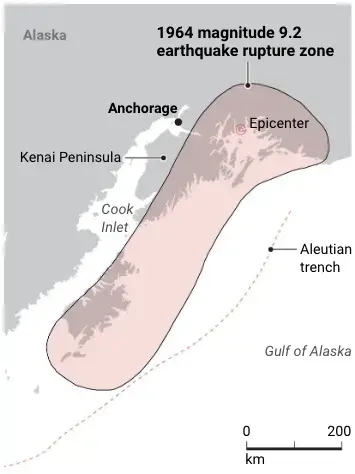Low tide helped city dodge catastrophic 1964 wave, but future ones could destroy critical port, highways
On a cold March evening in 1964, a colossal earthquake struck off the coast of Alaska. At magnitude 9.2, it was the largest earthquake ever recorded in North America, and it triggered massive tsunamis that killed more than 120 people and leveled communities. But no wave reached Anchorage, the state’s biggest city. Many concluded that nearby geography makes the city immune to tsunamis.
A new study published this week by the Alaska Division of Geological and Geophysical Surveys (DGGS), however, finds Anchorage simply got lucky in 1964—and might not the next time an earthquake strikes the seismically active region. In a worst-case scenario—another giant rupture in a worse place at a worse time—a 10-meter wave could flood low-lying areas of the city and its critical port for more than 24 hours, according to the study.

As a nonprofit journalism organization, we depend on your support to fund more than 170 reporting projects every year on critical global and local issues. Donate any amount today to become a Pulitzer Center Champion and receive exclusive benefits!
“I think folks in Alaska should take this seriously,” said Diego Melgar, a tsunami scientist at the University of Oregon not involved in the study. He says other U.S. coastal communities would benefit from such an analysis. “This is exactly what we need to be doing at a national level.”
An entrenched public perception holds that Anchorage is protected from tsunamis by the long, shallow Cook Inlet. False alarms have reinforced the sense of invulnerability: In recent years, residents have dutifully heeded tsunami warnings and evacuated, but no wave has struck. After a 2018 evacuation, an Anchorage Daily News story quoted an oceanographer who said, “The science doesn’t lend itself to an inundation in Anchorage.”
The truth was no one had ever really examined the city’s tsunami risk in detail. So Barrett Salisbury, DGGS earthquake and tsunami hazard program manager, and Elena Suleimani, the Alaska Earthquake Center’s tsunami modeler, recently took a closer look. They began by simulating the 1964 earthquake, which occurred when the Pacific tectonic plate, which plunges underneath Alaska, ruptured by as much as 20 meters. Their tsunami model traced the resulting wave toward Anchorage through the long Cook Inlet, which has uncommonly large tides. They discovered that when the 3-meter-tall wave reached Anchorage, hours after the earthquake, the city happened to be at low tide, 4 meters below the mean. The low tide simply muffled the tsunami. With a different earthquake timing, the inlet’s tides could have just as easily amplified it.
Concerned, the scientists looked to the future, modeling hypothetical earthquakes at different locations and times of day, based on the earthquake zone’s behavior in several thousand years of paleoseismic records. In the worst scenario—a magnitude 9.2 rupture striking farther south than the 1964 earthquake and triggering a tsunami that arrives at high tide—a 10-meter-tall wave would swamp Anchorage. “We need to take it seriously, even though it’s a low-probability event,” Salisbury says.
Salisbury and Suleimani found most residential areas would be out of harm’s way, but the Port of Alaska, which processes most of the state’s food, fuel, and consumer goods, would be inundated. “It’s kind of shocking how much we depend on the Port of Alaska,” Suleimani says. “We don’t have a backup.” The wave would also flood the critical single highway connecting Anchorage to Canada and the rest of the continental United States.

Jim Jager, Port of Alaska deputy director, remembers hosting tsunami scientists at his docks years ago and being reassured the port was safe. He admits he perpetuated the idea, asking the state for funding to modernize the port’s infrastructure because unlike others elsewhere, his couldn’t be wiped out by a tsunami. Briefed on the DGGS report, Jager now plans to fortify the docks and install backup batteries above the inundation zone so that supplies could be unloaded even amid a blackout. “If the docks get wiped out, how are we going to get food?” he asks. “If you look at any [emergency] plan for responding to and recovering from an earthquake, as soon as the Port of Alaska is inoperable, the plan collapses.”
Hermann Fritz, a tsunami expert at the Georgia Institute of Technology, thinks the study’s models are solid. But he says the study doesn’t account for another kind of tsunami: secondary ones that arise when earthquakes shake loose landslides that crash into the sea and Alaska’s many narrow fjords. For example, he says, a 1958 earthquake in southeastern Alaska triggered the Lituya Bay landslide, which created a 524-meter-tall wave—the largest ever recorded on Earth. With tsunamis, “there are always surprises,” Fritz says.
With the report out, the next step is educating the public about the newly recognized hazard. At the front lines will be Anchorage Office of Emergency Management Programs Manager Audrey Gray. She’s glad to have a study backing up her gut feeling that the city is not immune to tsunamis. Now, her office is updating emergency operation plans and has launched a joint information system to unify messaging across government agencies. A series of public meetings will begin in September. “The saying is all roads lead to Anchorage up here,” she says. “And we’ve got a road ahead of us, I’ll definitely tell you that.”









